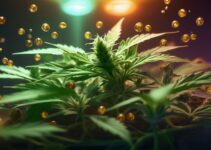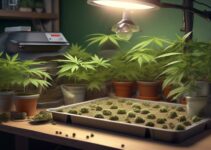When it comes to growing hemp, envision starting with a solid foundation, much like laying the groundwork for a sturdy building. Proven hemp germination techniques play a pivotal role in establishing this groundwork, ensuring the successful and healthy growth of your plants. But why should you prioritize these techniques? Well, the answer lies in the potential for maximizing your crop yield and nurturing robust, high-quality hemp plants. There's more to it than meets the eye, and understanding the nuances of germination is the first step towards a flourishing hemp cultivation journey.
Key Takeaways
- Reliable germination techniques are crucial for successful hemp cultivation and ensure synchronized growth among seedlings, maintaining uniformity in the crop.
- High-quality seeds with intact shells and mature appearance maximize the chances of successful germination and selecting certified and reputable genetic lineage seeds increases the likelihood of optimal performance and desired plant traits.
- Desirable genetic traits and characteristics contribute to successful germination, and synchronized growth and robust root development among seedlings are more likely with high-quality seeds.
- By selecting high-quality seeds from reputable sources and controlling environmental factors, using suitable germination substrates, and staying informed about the latest advancements in germination techniques, growers can create an optimal environment for hemp seeds to germinate and develop into healthy seedlings.
Importance of Reliable Germination Techniques
To ensure the successful cultivation of hemp plants, it is imperative to emphasize the importance of employing reliable germination techniques. Germination is the process by which a seed develops into a new plant. When it comes to hemp cultivation, using the best germination techniques is crucial for obtaining high-quality seeds and ensuring the robust growth of seedlings. Proper germination techniques are particularly essential for cannabis, as they allow the full genetic potential of different strains to be expressed.
By using reliable germination techniques, you can ensure synchronized growth among seedlings, which is vital for maintaining uniformity in the crop. This minimizes the risk of crop loss due to failed germination or weak seedlings. Additionally, reliable germination techniques play a significant role in increasing the yield potential of hemp plants. They establish healthy seedlings with robust root systems, setting the stage for successful plant development.
To get the best results from germination, it's crucial to pay attention to factors such as soil quality and moisture levels. By employing proven germination techniques, you can set the foundation for a successful hemp cultivation process.
Seed Quality and Selection Criteria
When choosing hemp seeds for germination, it is crucial to prioritize quality and selection criteria. By opting for high-quality seeds with intact shells and mature appearance, you can maximize the chances of successful germination and desired genetic potential. Selecting certified and reputable genetic lineage seeds is essential for increasing the likelihood of optimal performance and desired plant traits.
Seed Quality Criteria
Selecting high-quality hemp seeds is crucial for ensuring successful germination and optimal plant development. When choosing hemp seeds, look for intact shells, mature appearance, and reputable genetic lineage. It's essential to choose high-quality seeds from reputable breeders or seed banks to ensure higher chances of germination success and desired plant characteristics. Genetic stability and high germination percentage in certified hemp seeds are crucial criteria to consider. By selecting seeds with these qualities, you maximize the potential for a successful harvest. Here's a comparison table to help you understand the key seed quality criteria:
| Seed Quality Criteria | Description |
|---|---|
| Intact Shells | Seeds should have unbroken, undamaged shells for optimal protection and viability. |
| Mature Appearance | Look for seeds with a mature, healthy appearance, avoiding any signs of immaturity or damage. |
| Reputable Genetic Lineage | Choose seeds from reputable breeders or seed banks to ensure consistent and desirable traits. |
| Genetic Stability | Opt for seeds with stable genetic characteristics, ensuring predictability in plant development. |
| High Germination Percentage | Certified hemp seeds with a high germination rate offer increased chances of successful germination. |
Ensuring these criteria are met will set the stage for successful germination and healthy plant development.
Selection Considerations
Quality and selection criteria for hemp seeds play a vital role in ensuring successful germination and robust plant development. When selecting hemp seeds for cultivation, it is essential to provide an ideal environment for germination, including the appropriate pH level and environmental conditions. To maximize the likelihood of successful germination and desired traits, consider the following selection criteria:
- Choose high-quality seeds from reputable breeders or seed banks to ensure genetic integrity and robust germination.
- Assess seed appearance for intact shells, mature appearance, and reputable genetic lineage.
- Select seeds with a high germination rate and genetic stability to increase the chances of successful germination.
- Maximize the potential for a successful harvest by choosing seeds with known and desirable genetic profiles.
Germination Success Factors
To ensure optimal germination success for hemp seeds, focus on selecting high-quality seeds from reputable breeders or seed banks. When choosing seeds, look for intact shells, a mature appearance, and a reputable genetic lineage. This ensures higher chances of germination success by selecting high-quality seeds with desirable genetic traits and characteristics. High-quality seeds also increase the likelihood of synchronized growth and robust root development among seedlings, maximizing the potential for a successful harvest. Consider the following factors when selecting hemp seeds for germination success:
| Factors | Description |
|---|---|
| Seed Quality | Intact shells, mature appearance, reputable genetic lineage |
| Genetic Traits | Desirable genetic traits and characteristics |
| Synchronized Growth | Higher likelihood of synchronized growth and robust root development |
Creating the Ideal Germination Environment
To create the ideal germination environment for hemp seeds, it is essential to control factors such as temperature, humidity, light, and airflow. Ensuring optimal conditions for seed activation and early growth promotes consistent and efficient cultivation practices. Properly managing these elements establishes a favorable environment for seedling development, leading to successful germination and healthy plant growth.
Optimal Temperature and Humidity
Maintaining the ideal temperature and humidity levels is crucial for fostering successful germination and early growth of hemp seeds. To create the perfect germination environment, consider the following:
- Consistently monitor the temperature and humidity to ensure the ideal conditions for seed activation and growth.
- Utilize a proven germination method that regulates temperature and humidity to support optimal germination.
- Provide the right soil moisture and air humidity to encourage healthy seedling development.
- Ensure that the water content in the soil and surrounding air is balanced to promote synchronized and vigorous growth among the seedlings.
Proper Light Exposure
Creating the ideal germination environment for hemp seeds requires not only maintaining optimal temperature and humidity but also ensuring proper light exposure, which is essential for promoting seed activation and early growth. Adequate sunlight is crucial for initiating the germination process and supporting the seedlings' early development. When using the paper towel method for germination, it's important to place the seeds in a well-lit area with indirect sunlight. For optimal results, ensure that the temperature and humidity are also carefully controlled to provide a favorable environment for the seeds. By incorporating the right balance of light, temperature, and humidity, you can establish an ideal setting for the germination and early growth of hemp seeds.
| Factors to Consider | Importance | Tips for Implementation |
|---|---|---|
| Sunlight exposure | Essential | Provide indirect sunlight for seed activation. |
| Temperature and humidity control | Crucial | Maintain optimal conditions for seedling development. |
| Integrated approach | Vital | Balance light, temperature, and humidity for successful germination. |
Importance of Air Circulation
For optimal hemp seed germination and early growth, ensuring adequate air circulation is crucial to promote healthy seedling development and prevent mold and fungal growth. Proper air circulation facilitates gas exchange essential for seed germination and early growth while maintaining consistent temperature and humidity levels throughout the germination process. It also supports the development of sturdy stems and robust root systems by providing adequate airflow. Maintaining optimal air circulation can be achieved through various methods such as using fans or natural ventilation. Additionally, periodic monitoring of humidity levels and conducting a soil test can help in adjusting the environment to ensure the seeds germinate and thrive. Incorporating these techniques into your hemp germination process can significantly improve the success rate of growing cannabis.
Choosing Effective Germination Methods
To ensure successful hemp germination, the selection of appropriate germination methods is crucial for establishing uniform and healthy seedlings. When choosing effective germination methods, hemp growers must prioritize proven techniques that promote robust root development and synchronized growth among seedlings. Start by selecting high-quality seeds from reputable sources, as this increases the likelihood of successful germination. Next, focus on controlling environmental factors such as temperature, humidity, light, and airflow to create the ideal germination conditions. It's important to use suitable germination substrates and mediums that support healthy root development and overall growth. By employing these methods, growers can ensure that their hemp seeds germinate effectively, leading to the establishment of a strong and uniform crop. Additionally, staying informed about the latest advancements in germination techniques can further enhance the effectiveness of the chosen method. Ultimately, the goal is to create an optimal environment for hemp seeds to germinate and develop into healthy and thriving seedlings.
Optimal Substrates and Mediums for Germination
When implementing effective germination methods for hemp seeds, the choice of optimal substrates and mediums plays a critical role in supporting robust root development and synchronized growth among seedlings. Selecting suitable options such as peat pellets, rockwool cubes, coco coir, or a seed starting mix is essential for providing a conducive environment for seedling growth. These mediums ensure well-draining properties while retaining sufficient moisture, creating conditions conducive to successful germination. By choosing the right substrates and mediums, you are supporting healthy root development and overall growth, setting the stage for strong and vigorous hemp plants.
In summary:
- Select suitable options like peat pellets, rockwool cubes, coco coir, or a seed starting mix
- Ensure the medium is well-draining and retains sufficient moisture
- Provide a suitable environment for seedling growth
- Create conditions conducive to successful germination
Environmental Factors Affecting Germination
Understanding the role of environmental factors is crucial for optimizing hemp seed germination. Various factors like temperature, humidity, light, soil composition, and airflow significantly impact the germination process. Ensuring that these factors are carefully managed is essential for successful hemp seed germination. This can be achieved by creating an environment that meets the specific requirements of hemp seeds, providing them with the best possible conditions for germination. Below is a table summarizing the environmental factors affecting germination:
| Environmental Factor | Impact on Germination |
|---|---|
| Temperature | Seed activation and growth |
| Humidity | Successful germination |
| Light Requirements | Seedling development |
| Soil Composition | Nutrient provision |
| Airflow | Optimal germination conditions |
Troubleshooting Common Germination Issues
If you frequently encounter issues with hemp seed germination, troubleshooting common problems can significantly improve your success rate. When dealing with germination issues, it is essential to identify signs of poor germination, such as delayed or uneven sprouting. Addressing potential causes like incorrect moisture levels or inadequate warmth is crucial for successful germination. Preventing seedling diseases and fungal issues through proper hygiene and environment management is also essential. Additionally, adjusting germination methods or techniques based on observed issues can help improve the germination process. Seeking advice from experienced growers or resources for specialized troubleshooting assistance can provide valuable insights and solutions to common germination problems.
- Identifying signs of poor germination, such as delayed or uneven sprouting
- Addressing potential causes like incorrect moisture levels or inadequate warmth
- Preventing seedling diseases and fungal issues through proper hygiene and environment management
- Adjusting germination methods or techniques based on observed issues
Frequently Asked Questions
Why Is the Germination Process Important?
The germination process is important because it ensures seed viability, maximizes growth potential, and promotes nutrient absorption and root development. It directly impacts crop yield, plant health, and overall farming success, aligning with industry standards.
How Can You Enhance the Germination of Hemp Seeds?
To enhance the germination of hemp seeds, treat seeds, ensure optimal conditions, and provide meticulous seedling care. These practices can improve germination rate, seed viability, and germination success by controlling environmental factors.
Why Is It Important to Study Germination?
Studying germination is important due to its significance in seed viability, plant growth, and environmental factors influencing seedling development. It has wide research applications and is crucial for optimizing agricultural practices.
What Is the Most Important Part of Germination?
To ensure successful germination, monitor seed moisture, regulate temperature, and assess seed viability. Quality germination techniques are crucial for optimizing seedling development and increasing germination rate. Proper technique directly impacts seed quality.





